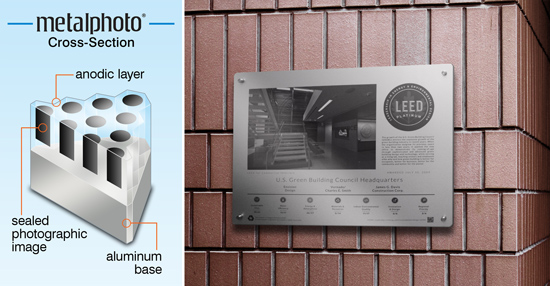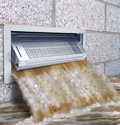Designing for Extreme Environments
Durable Communication
Designing the needed signage in safe rooms or FEMA Shelters is fairly straightforward. Picking the best material and signage system so that it remains intact and readable for years or decades to come during both normal and extreme weather use requires some attention to detail. First, it is necessary to understand the potential conditions that the signage will encounter. Any exterior signage needs to handle weather of all types, such that it holds up against precipitation, heat, freezing, condensation, wind, and all related conditions. It must also be able to remain clear without clouding or fading from bright sunlight, which carries color damaging ultraviolet (UV) radiation. In public places, whether the signage is placed indoors or out, it must be vandal resistant and easily cleaned in the event of any markings from people, graffiti, etc. In all, the signage needs to be as tough as the safe rooms and shelters that they are directing people to.
There are certainly a number of choices of materials to consider, but one that is particularly noteworthy is photosensitive anodized aluminum. This is a specialized type of anodized aluminum used to make durable, high-resolution signage. The material was first developed in 1950 for the U.S. Navy and has been reliably used since then by many engineers, designers, and architects for permanent identification of items installed in harsh environments. Some noteworthy applications include things like international space station labels, off-shore crane nameplates, labels, and control panels, along with signage and labels on army tanks and aircraft carriers. The material has held up for decades despite these unusually harsh environments, which include extreme temperature swings, intense UV exposure, corrosive salt-spray, and sand abrasion. In 2011, the U.S. Navy conducted an evaluation of 73 materials used for these type of identification and communication purposes. That test found photosensitive anodized aluminum earned more high scores than any other material evaluated.4
The manufacturing process to make this aluminum signage is essentially a photographic process using a silver-halide-based image that is sealed inside of the anodic layer of anodized aluminum. Hence, it becomes part of the aluminum base, not something that is applied on top and not something that is etched. As such, it is as durable as any anodized aluminum finish and just as resistant to fading or abuse. As a photographic medium, the graphic image capabilities are practically limitless. Architects and designers can use it to reproduce and display detailed drawings or photographs as well as signage. The other advantage of the photographic nature is that it can easily create variable data—producing hundreds or thousands of unique signs with different information, QR codes that link to websites, or other variable, custom-designed information.
Photosensitive anodized aluminum typically produces a black and silver photographic image. Color can be added but is not recommended for long-term outdoor usage unless it is protected with a laminate. Either way, the material allows designers to capture rich, photographic-quality images inside of the metal itself, thus providing its notable longevity and durability all in the contemporary look of anodized aluminum. The material is generally available in four finishes including matte, #4 heavy grain, gloss, and satin/mill. It can be specified in thicknesses as thin as three thousandths of an inch up to an eighth of an inch, depending on project needs and mounting conditions. While it will not need to be replaced as often as other signage, if replacement is desired, this all-aluminum product is 100 percent recyclable.
The cost of this type of signage will vary by size and thickness of the plates desired. When architects can work directly with the manufacturer, prices tend to be below market rates for other types of architectural signage. That means it may also make sense to coordinate it with other signage used in a building project. That could include address signage, general wayfinding, donor recognition, custom facade treatments, educational signage, and even building certification plaques, such as LEED recognition plaques.

Images courtesy of Metalphoto® Photosensitive Anodized Aluminum
Photosensitive anodized aluminum signage creates photographic imagery embedded inside the anodic layer, contributing to long-lasting, durable, and fade-resistant communication.
Conclusion
Severe weather is increasingly becoming a design concern for many buildings. This is true for a number of weather types, but particularly for flooding, tornadoes, and hurricanes. Understanding the design issues, code requirements, and standards for performance allows architects and other design professionals to incorporate mitigation measures into new and renovation building projects. Successfully doing so will allow buildings to be resilient enough to survive these severe weather events, but more importantly help people to survive.
Peter J. Arsenault, FAIA, NCARB, LEED AP is an architect and green building consultant who has authored more than 120 continuing education and technical publications as part of a nationwide practice. www.linkedin.com/in/pjaarch
Endnotes
- Storm Events Database. National Oceanic and Atmospheric Administration. Sept. 2015. Web. 22 Jan. 2016. www.ncdc.noaa.gov/stormevents.
- Katz, Richard and Smith, Adam. U.S. Billion-Dollar Weather and Climate Disasters: Data Sources, Trends, Accuracy and Biases. Natural Hazards, 3 Feb. 2013. Web. 22 Jan. 2016. http://link.springer.com/article/10.1007/s11069-013-0566-5.
- FEMA P-361: Safe Rooms for Tornadoes and Hurricanes: Guidance for Community and Residential Safe Rooms. Third Edition, March 2015, 28 Dec. 2015. Web. 22 Jan. 2016. www.fema.gov/fema-p-361-safe-rooms-tornadoes-and-hurricanes-guidance-community-and-residential-safe-rooms.
- Item Unique Identification (IUID) Environmental Survivability Testing Report: Independent Assessment of Vendor-Supplied Materials. Rep. Vol. 1.0. Corona Division Item Unique Identification (IUID) Center: Naval Surface Warfare Center, Aug. 2011. Web. 22 Jan. 2016. http://www.acq.osd.mil/dpap/pdi/uid/docs/IUID_Environmental_Survivability_Testing_Report.pdf.
 |
|
 |
Notice

www.ambico.com and www.securitech.com

details.mpofcinci.com/extreme-environment-signage/

www.smartvent.com










